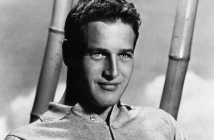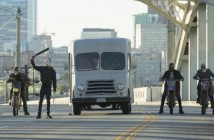
Our Nixon
Top Ten (recent) Political Documentaries
Editor’s Notes: Freida Lee Mock’s Anita is out in limited release today.
It is often a mistake of mainstream audiences that Documentaries are simply another genre of film – in opposition to drama, horror or sci-fi etc. But anyone who has an interest in non-fiction filmmaking knows that there are a huge variety of different types of films. Documentaries can focus on science/nature, human-interest, history, biography or politics amongst many other generic nuances.
Theoretical arguments around representation suggest that the very act of capturing a certain area of ‘real life’ is in itself political, as the choice of what to include and omit has consequences about what audiences will think about any given subject matter. But if a ‘political documentary’ is defined as a film that presents one or more arguments focusing on an area of Political policy (a decision made by a government) then these are ten of my favourite recent examples.
1. Our Nixon
Perhaps the most ‘pure’ documentary on the list, Our Nixon is made entirely of archive 8mm footage collected by Richard Nixon’s inner circle of aides. They obsessively documented everything around them – perhaps due to the excitement of having early access to a relatively new medium, perhaps due to the heightened ego of those involved presuming that they were at the centre of the political universe… if only they knew that they would be capturing arguably the most notorious political scandal in human history.

Highway of Tears
2. Highway of Tears
During the 1960s, a number of Aboriginal woman were going missing on a particular stretch of highway on the West coast of Canada. It became known as the Highway of Tears due to the number of unsolved cases, only getting national attention when a young white girl went missing. The documentary focuses on the disconnect between the media reaction concerning missing Aboriginal and white ethnic women as well as exploring the story of the racist state policy of separating Aboriginal children from their families to educate them in a more ‘white’ environment.
3. Dirty Wars
Cinematographer Rick Rowley joins iconoclastic journalist Jeremy Scahill to tell the little understood story of the Joint Special Operations Command strikes in Afghanistan. Working as a sober counterpart to the fantastical Zero Dark Thirty, the film begins with a raid on a family party that killed a number of Afghan citizens mistaking them for ‘insurgents’. If anything can pop the liberal bubble surrounding Obama then it is this film.
4. Gasland
When Josh Fox got a letter stating that he could make up to $100,000 selling part of his land to corporate fracking companies, he decided to investigate into what these relatively new companies actually did and what the environmental implications might be. His journey led to water taps that burst into flames, dead animals and ultimately a kind of conspiracy on the part of state regulators that were providing huge financial profits to intensely pollutant companies. His work led him to eventually direct a sequel film that is just as frightening…

5. The House I Live In
5. The House I Live In
Eugene Jarecki is a master of political documentaries, but this film from 2012 about American drug policy feels like Game, Set and Match to his side of the argument. He systematically documents the disproportionate effect that the ‘war on drugs’ has on poor and ethnic minority communities.
One of the most shocking parts of the film is the ignorance of the (mostly white) general public on the street about whom their government is locking up. A terrifying film that could be seen in years to come as a tipping point in the relaxing of drug legislation.
6. How To Survive A Plague
During the 1980s, America began to discover that it was facing a public health crisis so severe that the only way to deal with it was to pretend it wasn’t happening, and therefore condemn an army of people to suffering and eventual death. The only reason that this was allowed to happen was that it primarily affected the metropolitan gay communities that civil society at that time happened to despise anyway…
This inaction on the part of the government (Reagan never once publically uttered the word ‘AIDS’) cost thousands of lives and forced communities to become activists and save themselves. Much like Our Nixon above, HTSAP is made up mostly of archive footage filmed at the time – making the film a valuable and poignant social document of a group of radicals that managed to change their lives for the better through their own resourcefulness and determination…
7. Fire in the Blood
…however, the story unfortunately continues in a different continent in a much more tragic way. Africa is beginning to develop the disease at epidemic levels and Western authorities were reluctant to help them in case it reversed the good work that they were doing to help the cosmopolitan Americans/Europeans. This led to a hideous betrayal of scientific and medical principles as commerce and ‘big pharma’ was allowed to overtake social responsibility.

Katiyabaaz [Powerless]
In the city of Kanpur in northern India a fight is going on between national electricity suppliers (especially KESCO) and gangs of vigilante street pirates that illegally sabotage electricity transformers in order to link poor households into the grid. The protagonist of the film is the cheeky Loha Singh who tries to wage a David vs. Goliath style battle against the managing director Rita Maheshwari. What results is a gripping tale of power vs. Power set amidst massive poverty and corruption.
9. Pussy Riot: A Punk Prayer
When three women sang a punk song in a church in Moscow to protest against the state, they probably didn’t know that the act would lead to them being imprisoned for years and becoming national pariahs/international heroes. Mike Lerner’s film manages to combine punk aesthetics with interviews with Russian citizens, diplomats and scary Russian-Orthodox neo-fascists to create a state-of-the-nation look at government might and Russian society at large.
10. The Square
In 2011 Egypt followed in the footsteps of Tunisia and had a revolution that led to the overthrow of Hosni Mubarak. This was the beginning of what has largely been patronizingly classified (in the West) as the ‘Arab Spring’. The civil disobedience in the country largely centred in a part of Cairo called Tahir Square: a roundabout that hosted a community of protesters that promised to live in tents until they got modest emergences of democracy. The Square follows a number of people as they risk everything for principles that people in Western countries take for granted every day… an ultimately humbling experience.




Pingback: Kym Barham()
Pingback: http://cutierabbit.bloggplatsen.se/gilla/?url=http://crossroadscelticfestival.com()
Pingback: ecografe()
Pingback: werken bij islive()
Pingback: how to get free netflix 2016()
Pingback: banheira()
Pingback: guitar picks()
Pingback: guitar picks()
Pingback: online deals()
Pingback: yspro.ne.jp()
Pingback: greenwriting()
Pingback: chapter 7 attorney carlisle()
Pingback: best online shopping()
Pingback: real raspberry ketones()
Pingback: esta()
Pingback: automotive locksmith houston()
Pingback: Toni Besanson()
Pingback: go to my blog()
Pingback: you could check here()
Pingback: official site()
Pingback: Issac Wanner()
Pingback: Best buy iPhone Samsung accessories()
Pingback: Ecograf()
Pingback: curso de detetive profissional()
Pingback: movie2k()
Pingback: paintless dent repair training()
Pingback: zubin medora()
Pingback: valentinesday()
Pingback: ramalan bintang()
Pingback: puppy playpen()
Pingback: 6 wheel truck()
Pingback: Wiki links()
Pingback: German Saxinger()
Pingback: free casino games()
Pingback: http://blog.seo.hcore.pl/projektowanie-strony-internetowej/()
Pingback: garcinia cambogia 80 hca free trial()
Pingback: Silkscreen()
Pingback: ejakulasi dini()
Pingback: ebay deals of the day india()
Pingback: handicapped transportation()
Pingback: Low Voltage Installers()
Pingback: Logo design sydney()
Pingback: poker()
Pingback: sacred 3 trainer()
Pingback: Elizabeth Swann Miller()
Pingback: Buy Adipex()
Pingback: at here()
Pingback: Pest Control Perth()
Pingback: Schluesseldienst Berlin()
Pingback: eyelash extensions services()
Pingback: mental health()
Pingback: dr oz vitamin c serum()
Pingback: VigRX Plus()
Pingback: Cake Delivery In Hyderabad()
Pingback: news()
Pingback: stlpiky()
Pingback: you can try this out()
Pingback: marketing consultant twin cities()
Pingback: Enda Sprinkles()
Pingback: Carina()
Pingback: free porn()
Pingback: my singing monsters hack apk()
Pingback: Drawing For Kids()
Pingback: eating healthy busy()
Pingback: british used clothing()
Pingback: ahana()
Pingback: Probiotic Supplements()
Pingback: medical marijuana evaluations san francisco()
Pingback: Superior2009()
Pingback: bali flag()
Pingback: Jasa Tukang Taman Jakarta()
Pingback: overnight cat sitters naples()
Pingback: Quickbooks help number()
Pingback: News Magazine()
Pingback: movietube()
Pingback: see more()
Pingback: white kidney bean extract ingredients()
Pingback: seller sku()
Pingback: GPS Tracker()
Pingback: garcinia cambogia or hydroxycut()
Pingback: how can i make money online()
Pingback: PURCHASE AUTOMOBILE INSURANCE()
Pingback: Self Balancing 1000()
Pingback: clickbank()
Pingback: human resources()
Pingback: investigative()
Pingback: ollas rena ware()
Pingback: diabetes review()
Pingback: bathroom scale vector()
Pingback: sticky notes calendar program()
Pingback: cf card 1gb()
Pingback: Motor Club of America review()
Pingback: Cash 4 Clothes()
Pingback: music()
Pingback: punta cana dominicana()
Pingback: IATA Cat Box in Sri Lanka()
Pingback: العاب فلاش()
Pingback: Canberra landscaping()
Pingback: Crazy bulk D-bal()
Pingback: Automated Trading System()
Pingback: dryer vent hose()
Pingback: custom web design()
Pingback: Cherise()
Pingback: cerrajeros de elche()
Pingback: https://in.pinterest.com/pin/361062095104131929/()
Pingback: Thai Porn()
Pingback: www.rosengard.tv()
Pingback: Femme de menage a Brossard()
Pingback: icc t20 world cup 2016()
Pingback: best mattress 2016()
Pingback: furniture movers()
Pingback: Discover More Here()
Pingback: fly swatter pics()
Pingback: mini caddy organizer()
Pingback: Robert G. Creely Attorney()
Pingback: Crazy Bulk Coupons()
Pingback: cerrajeria san juan()
Pingback: Hypnosis Toronto()
Pingback: free messenger guide()
Pingback: the walking dead saison 7 streaming gratuit()
Pingback: carpet cleaning Austin()
Pingback: Sean Treacy()
Pingback: FreeRushSale()
Pingback: my website()
Pingback: Wealthy affiliate make money online()
Pingback: https://www.facebook.com/sexiercom/()
Pingback: Credit Card Processing Companies()
Pingback: nyquil zzzz()
Pingback: Workout Clothes()
Pingback: USA Box Express()
Pingback: Indian Wedding Photography()
Pingback: porno()
Pingback: Best Video App()
Pingback: overnight cat sitter in naples()
Pingback: golf range netting()
Pingback: Make your own word search()
Pingback: BailBondsman()
Pingback: estate planning()
Pingback: estate planning Austin()
Pingback: english bulldog puppy()
Pingback: http://keepyourhair.cba.pl/()
Pingback: dog walking naples()
Pingback: Sterling Silver()
Pingback: exitus recruitment()
Pingback: The Lost Ways()
Pingback: porno()
Pingback: na online()
Pingback: Refrigerator Repair nyc()
Pingback: Nashville Wedding Photography()
Pingback: Body Shop Brooklyn()
Pingback: porno()
Pingback: Bowcutt Dental()
Pingback: Synergy spanish()
Pingback: Tao of Badass Joshua Pellicer()
Pingback: Singorama()
Pingback: Buy Forskolin Fuel()
Pingback: forskolin 500 mg()
Pingback: How to make a birch bark basket()
Pingback: Houston Low Cost Criminal Lawyer()
Pingback: watch movies free()
Pingback: cartoon porn()
Pingback: email lists()
Pingback: Skyzoo Type beat()
Pingback: are raspberry ketones safe()
Pingback: backflow repair()
Pingback: Michal()
Pingback: Spa North()
Pingback: learn german articles()
Pingback: how to send bulk sms from whatsapp()
Pingback: hoer()
Pingback: epic soccer training matt smith()
Pingback: love quotes and sayings()
Pingback: Party Bus rental()
Pingback: how to meet new people()
Pingback: Berras Sportfiske()
Pingback: textiles usages()
Pingback: whatsapp channel checker()
Pingback: expresspay bayad center()
Pingback: mexican jokes()
Pingback: superiorsingingmethod()
Pingback: Read More Here()
Pingback: 6-year-old red ginseng()
Pingback: porno()
Pingback: E Liquid()
Pingback: free bass samples()
Pingback: smoothies to lose weight()
Pingback: ssd shared hosting()
Pingback: voip pbx()
Pingback: binary options()
Pingback: please click the next website page()
Pingback: dig this()
Pingback: http://www.toprubbishclearance.co.uk/commercial-clearance-united-kingdom_barbican-city-of-london-ec2y.html()
Pingback: kids fashion()
Pingback: Summer Dresses()
Pingback: new born gifts()
Pingback: guitar loops()
Pingback: diet pills()
Pingback: ADO fanclub()
Pingback: freelance illustrator()
Pingback: McAfee Account Login()
Pingback: jet stupid()
Pingback: Marketing Company()
Pingback: SEO Bergen()
Pingback: bike phone charger()
Pingback: printingvip()
Pingback: multilingual seo expert()
Pingback: Obsession Phrases Examples()
Pingback: Digital()
Pingback: chlamydia()
Pingback: cute puppies()
Pingback: electric car insurance()
Pingback: Whip()
Pingback: Bettie Page()
Pingback: Editorial Magazine Photography Washington DC()
Pingback: Sabrina()
Pingback: web design nz()
Pingback: Public-Relations-Event-Photographer-Washington-DC()
Pingback: City Pro Dentists()
Pingback: absolutedanny.equityplays.date()
Pingback: Instagram()
Pingback: food storage benefits()
Pingback: california psychics reviews()
Pingback: Surgeon dentist()
Pingback: calvert county homes for sale()
Pingback: Buy Isagenix Online()
Pingback: Ottawa Fertility()
Pingback: cheat game android online()
Pingback: schedule sms()
Pingback: VIZBOX enclosures for outdoor projection()
Pingback: jewelry stores in tulsa ok()
Pingback: tulsa jewelry stores()
Pingback: spmauijim.guitarherobrokemyknee.com()
Pingback: dependable fence builder Austin()
Pingback: Kenyans()
Pingback: Grand Lake resorts()
Pingback: carpet cleaning Austin()
Pingback: kesihatan()
Pingback: mobile application development()
Pingback: Synergyspanish()
Pingback: online()
Pingback: Singorama 2.0()
Pingback: sleeping pills()
Pingback: verhuisbedrijf rotterdam()
Pingback: high seo ranking()
Pingback: Top 10 Animales en Peligro de Extinción()
Pingback: best home air purifier for pets()
Pingback: http://www.allareaoverhead.com/()
Pingback: ryobi outlet()
Pingback: home security Austin()
Pingback: http://bowcuttdental.com/()
Pingback: equityplays.date()
Pingback: Banner Printing()
Pingback: house painters Austin()
Pingback: Kalyan Matka()
Pingback: best interior design blogs()
Pingback: chat gratuit()
Pingback: freelance()
Pingback: Austin water damage()
Pingback: internet millionaire()
Pingback: epa e dha()
Pingback: http://www.waterdamagerestorationofaustin.com/()
Pingback: Pure Natural Healing Review()
Pingback: The Lost Ways Book Review()
Pingback: Fondue party chocolate meat cheese()
Pingback: Buy Beats Cheap()
Pingback: Streams()
Pingback: SEO Norway()
Pingback: singapore grants()
Pingback: rialudi()
Pingback: Personal trainer()
Pingback: zootopia 2016()
Pingback: Дивергент, глава 3: За стеной / Allegiant, Высотка / High-Rise,()
Pingback: Workshop()
Pingback: Coachella 2016()
Pingback: Managed Mobile Device Management Ocala FL()
Pingback: pinterest bot()
Pingback: style()
Pingback: Check This Out()
Pingback: clear bra straps()
Pingback: nordstrom coupon()
Pingback: Barton creek sewer repair()
Pingback: Builders north london()
Pingback: Bedside Lamps()
Pingback: mens hunting boots()
Pingback: real ways to make money online()
Pingback: best domain registrar()
Pingback: Best Promotion Gifts()
Pingback: Cabinet Hardware()
Pingback: keyword snatcher()
Pingback: Romance()
Pingback: hack para clash of clans()
Pingback: drive traffic()
Pingback: Centreville, va real estate()
Pingback: Read This()
Pingback: jvzoo scam()
Pingback: Unity Education()
Pingback: Brioni()
Pingback: Free WSET Course()
Pingback: meetyoursweet()
Pingback: how to play keyboard()
Pingback: HP spectre x360 review()
Pingback: IT Support Ocala FL()
Pingback: Birmingham()
Pingback: windows replacement()
Pingback: co insurance()
Pingback: Myanmar house()
Pingback: no credit check loans()
Pingback: Skimpy one piece()
Pingback: Men's magazine()
Pingback: iphone repair richardson()
Pingback: link kürzen()
Pingback: vipprinting()
Pingback: printing()
Pingback: Removals Gloucestershire()
Pingback: Alkaline()
Pingback: Coince investment()
Pingback: Used motorcycles for sale()
Pingback: iv therapy jobs nj()
Pingback: cheap transmission parts()
Pingback: On-Demand Trucking()
Pingback: stained concrete floors Austin()
Pingback: marketing land()
Pingback: peppa pig()
Pingback: your calvert calvert county homes for sale()
Pingback: discount transmission parts()
Pingback: organic cotton()
Pingback: Salome()
Pingback: finger family()
Pingback: mcdonalds delivery()
Pingback: Lady Remington()
Pingback: arco lamp replica()
Pingback: eb-5 lawyer alhambra()
Pingback: NO ID Theft()
Pingback: ambient()
Pingback: Tulsa Online Marketing()
Pingback: ignition fic locksmith mesa()
Pingback: crossbody bags()
Pingback: sciatica exercises()
Pingback: iv therapy day logo()
Pingback: fuck google()
Pingback: fuck google()
Pingback: type 2 diabetes blood sugar charts()
Pingback: liquid iv ft lauderdale()
Pingback: fuck google()
Pingback: fuck google()
Pingback: spiderman()
Pingback: mobil porn()
Pingback: nursery rhymes()
Pingback: fuck google()
Pingback: orzech amerykanski()
Pingback: porno izle()
Pingback: 他媽的谷歌()
Pingback: Photo Booth Hire London()
Pingback: linux vps()
Pingback: Bondsman Kent County Mi()
Pingback: Hampshire()
Pingback: 他妈的谷歌()
Pingback: Menswear()
Pingback: Deep Cleaning service Raleigh NC()
Pingback: 144hz blackhat seo buying guide()
Pingback: porno español()
Pingback: sklejka dlh()
Pingback: 他妈的谷歌()
Pingback: a line wedding dresses()
Pingback: John Xie()
Pingback: buy real youtube subscribers()
Pingback: Body Shaper()
Pingback: 他妈的谷歌()